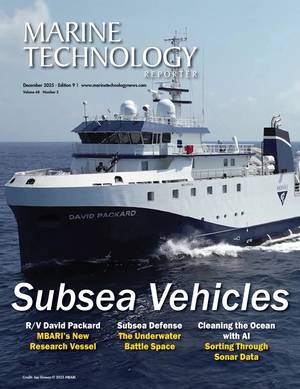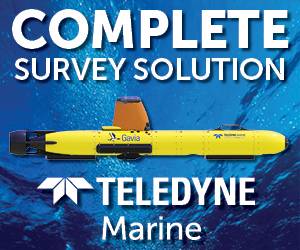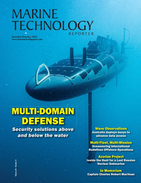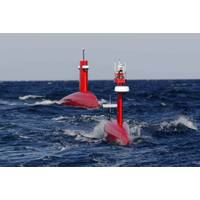
Exail Autonomous USV Travels 1,100-Nautical-Miles Across Gibraltar Strait
supervised autonomy from Exail’s Remote Operation Center (ROC) in La Ciotat, the mission demonstrated endurance, situational awareness, and reliable decision-making in dense traffic.This long-range deployment confirms the robustness, safety, and operational readiness of Exail’s surface drone technology. More than a symbolic crossing, it provides concrete proof that large USVs can be remotely supervised across open waters and constrained sea lanes, arriving fully mission-capable in theater without heavy logistical support. During the transit, the DriX O-16 also conducted seabed mapping operations
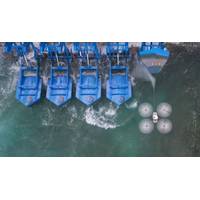
Future is Here: Smart Drones Take on Wave Energy Plant Upkeep (Video)
sites have historically reached up to 4% of project capital expenditure annually.“After celebrating the opening of our Los Angeles pilot on September 9, we are proud to take another bold step toward smarter, more scalable wave energy. Partnering with BladeRanger lets us integrate cutting-edge drone technology into our operations – making our systems cleaner, more efficient, and better prepared for global deployment,” said Inna Braverman, founder and CEO of Eco Wave Power.According to BladeRanger, which has supplied automated cleaning solutions to large-scale solar operators including
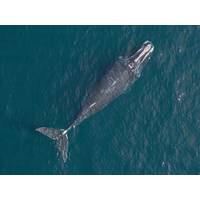
New England Aquarium Researchers Use Drone Technology to Monitor Climate Change Impacts on Whales
Scientists are using drone technology to study how changing ocean conditions are impacting whales, advancing this non-invasive research technique in both New England waters with North Atlantic right whales and in Alaska with killer whales.Scientists with the Anderson Cabot Center for Ocean Life at the New England Aquarium recently captured drone images of killer whale mothers with calves in Prince William Sound in the northern Gulf of Alaska during field research in June, in collaboration with the non-profit North Gulf Oceanic Society (NGOS). Photogrammetry uses high-resolution

Mocean Energy and Proserv Team Up for Low-Carbon Solutions for Subsea Ops
offshore energy sector and the blue economy, while helping to decarbonize oil and gas production,” said Cameron McNatt, Managing Director at Mocean Energy.“This agreement comes at a pivotal time for the Proserv business as we explore the integration of new technologies such as underwater drone technology for monitoring both wind and oil and gas, amongst other offerings to the wider energy industry, and Mocean Energy will deliver clear synergies in this new partnership,” added Davis Larssen, Proserv’s CEO

Advanced Navigation Opens Subsea Robotics Center in Australia
several marine simulation environments.The subsea center is one of several investments made by Advanced Navigation as it continues to expand its global reach and capabilities. The company has established headquarters in Sydney with research centers throughout Australia, including Brisbane for aerial drone technology, Canberra for photonic and laser technology and Newcastle for quantum sensing.In addition to novel autonomous subsea robotics, Advanced Navigation delivers AI-enhanced navigation technologies for land, sea, air and space applications
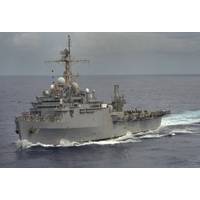
Ex-USS Denver Served Until Sunk
training opportunity, the Repair Technology Exercise 2022 (REPTX), was conducted in Port Hueneme, Calif., from August 22 to September 2, 2022. Southwest Regional Maintenance Center (SWRMC) participated in the REPTX and demonstrate their new Diving Support Vehicle as well as their underwater drone technology.Technical demonstrations and field experiments were conducted aboard the Navy’s Self Defense Test Ship, the ex-USS Paul F. Foster (DD 964), an asset of Naval Surface Warfare Center Port Hueneme Division (NSWC PHD).According to a news release from NSWC-PHD, REPTX offers a unique opportunity
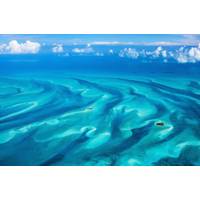
How AI Can Help Protect the Oceans
can build AI water sampling drones to tell us about life underneath. (© driftwood / Adobe Stock)What’s next?Imagine having autonomous floating or underwater drones sampling seawater, with AI neural networks looking for fish DNA. It sounds like sci-fi, but it’s now entirely possible. Drone technology has matured. AI tools have arrived. And we no longer need to catch fish to know what lives in the seas. All you need are tiny traces of environmental DNA marine species leave behind in water. Similarly, we could track coral reef ecosystem health in near real time.This will let us take the pulse

MTR100: For USVs and AUVs, is it a Hydrogen Future?
of the founders of ACUA Ocean.ENDURUNSThe ENDURUNS USV, en-route to Cyprus. Image courtesy ENDURUNSOver in Europe, combining hydrogen powered, long-endurance AUVs with hydrogen powered support USVs is the goal of the collaborative ENDURUNS project.The consortium includes space, defense, marine and drone technology companies, universities, institutions, consultancies, a certification body and a port from Greece, the UK, Korea, Denmark, Italy, Spain, Switzerland, Lithuania, Belgium and Cyprus. Their goal is a 5.5m-long, hydrogen fuel cell powered hybrid AUV, with a Li-ion battery for supplementary
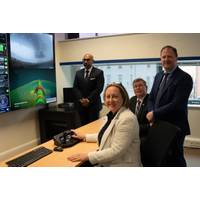
Modus Launches Darlington Control Room for Subsea Hybrid AUVs
the third and fourth to be delivered in October 22 and mid 2023, respectively.Trevelyan was invited to pilot one of the vehicles around the port of Sunderland via remote connection. She said: “It’s been fantastic to have the chance to discover the extraordinary work in underwater drone technology that Modus has been leading on. It’s genuinely world-leading, UK-first technology and I’m so proud that it’s here in Darlington"There’s amazing, brilliant leadership in this sector and Modus is absolutely leading the way. It’s so exciting to hear the opportunities

 December 2025
December 2025
